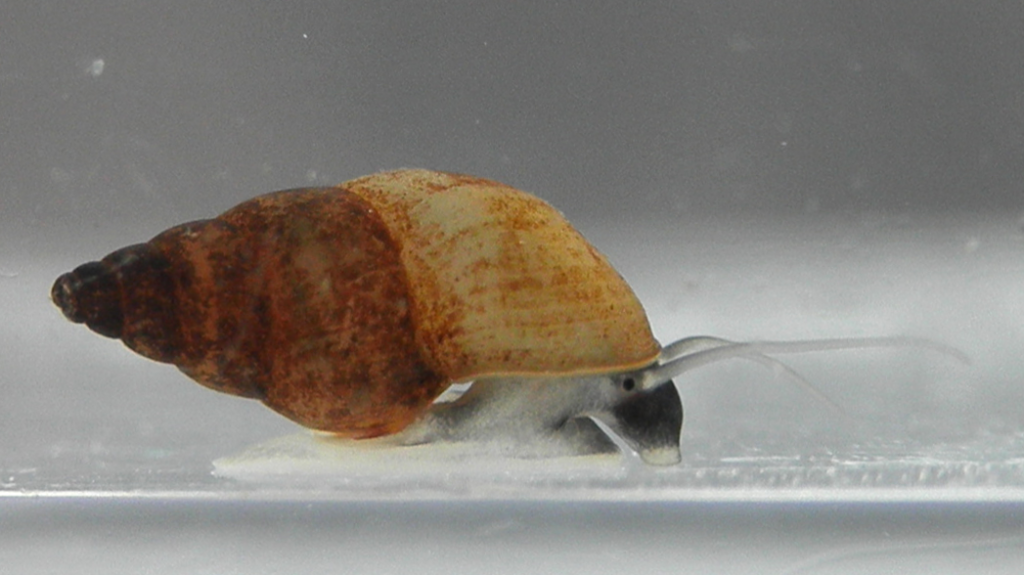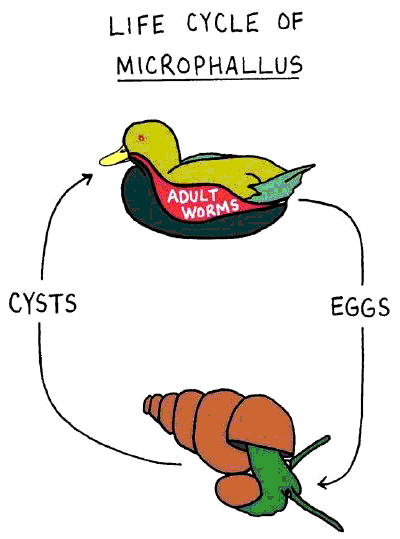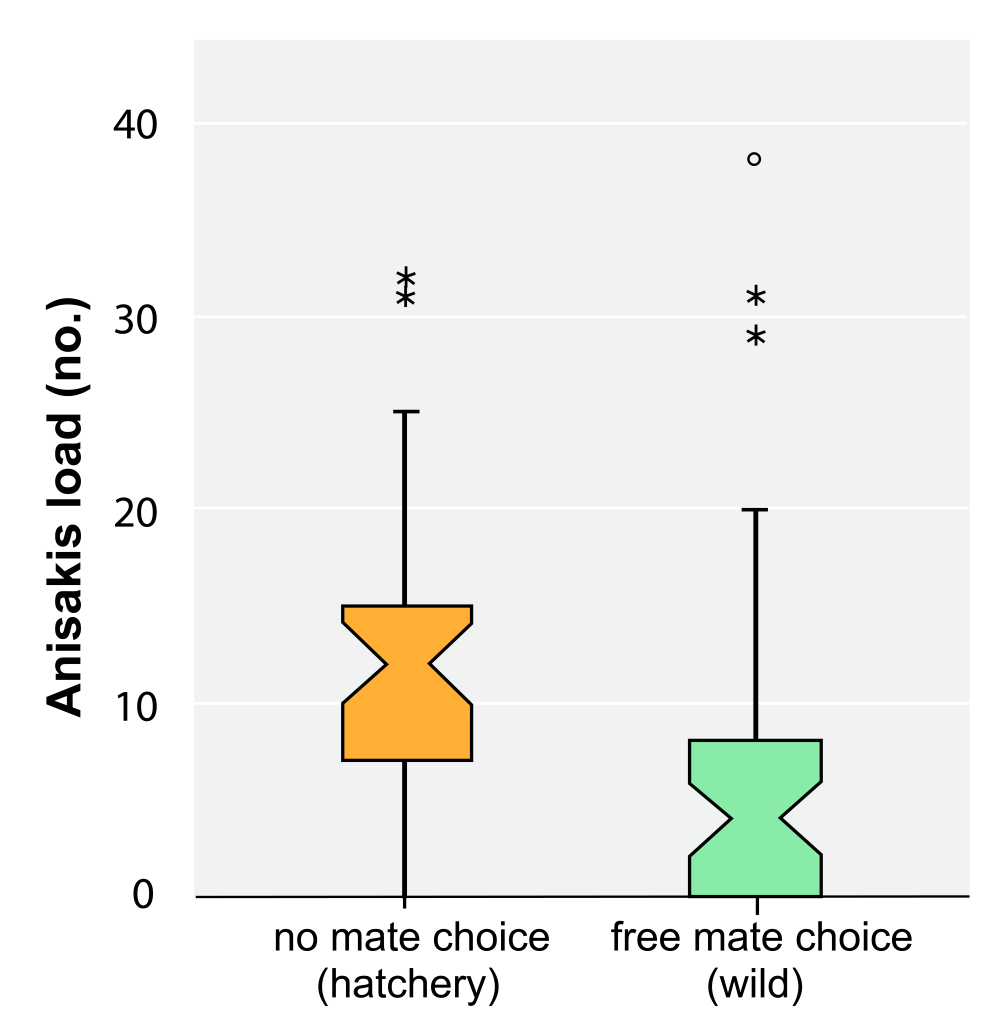7.5 Testing the Red Queen Hypothesis
The Red Queen hypothesis—that sex allows organisms to keep up in a race against coevolving pathogens—can be tested by analyzing three key predictions of this hypothesis:
- Sex is most beneficial where there is a high risk of infection.
- Pathogens are more likely to attack common phenotypes in a population (e.g. clones), as opposed to the less-common counterparts (such as the diverse set of organisms that resulted from sexual reproduction).
- In sexually reproducing populations, individuals choose mates that maximize diversity of their offspring.
Note that all of these predictions implicitly rely on the heritability of being healthy (in this case, the ability to combat pathogens); specifically, parents must be able to pass along to their offspring genes for avoiding pathogens. Testing these predictions has resulted in several lines of evidence supporting the Red Queen Hypothesis.
Prediction 1: Sex is most beneficial where there is a high risk of infection
An excellent system for testing this prediction involves a flatworm parasite in the genus Microphallus, a duck, and a small mud snail (Potamopyrgus antipodarum; Figure 7.7). This species of snail is able to reproduce sexually or asexually. The extent of sexual reproduction in a population of snails can be quantified by counting the number of males—asexual snails are all female.

The flatworm’s life cycle begins inside of the snail, where the worm emerges from its egg. Infected snails are consumed by ducks. Once in the duck’s intestine, adult worms have sex and produce eggs. Flatworm eggs are released, with duck feces, into the water, where they are ingested by snails and the cycle continues (Figure 7.8). Snails are harmed by this flatworm, largely because a symptom of infection is sterilization (the flatworm’s scientific name, Microphallus, translates to “small penis”).

Observations of this system in two New Zealand lakes (Alexandrina and Kaniere) revealed that snails are more likely to be sexual (measured by frequency of males) in shallow waters, where ducks feed, than in deeper waters, where ducks do not feed (Figure 7.9).

These results suggest that coevolutionary pressure is greater on the snails in the shallows, presumably because presence of feeding ducks makes the flatworms more common (remember that part of the flatworms’ lives is spent in duck feces). Higher infection rates in the shallows indicate that, in support of Prediction 1, sex is most beneficial where there is a high risk of infection.
Prediction 2: Pathogens are more likely to attack common phenotypes in a population, as opposed to the less-common counterparts
In the Mexican desert there are isolated pools inhabited by a species of minnow. Within these pools, populations of asexually reproducing individuals exist alongside sexually reproducing individuals. Fish in these ponds exhibit “black spot disease,” which is caused by a parasitic flatworm. Investigators have observed the frequency of sexual and asexual fish and the number of black spots in each type of fish in these ponds. Clonal fish are likely to have the most common phenotype in these ponds (as they are genetically identical to each other), while the sexually reproducing fish will have a wide variety of infrequent phenotypes. As the Red Queen Hypothesis predicts, the common type of fish (usually one of the clonal species) had the highest number of parasitic spots. In ponds where there was a genetically diverse, sexually reproducing population, the sexual fish had fewer spots.

Additional evidence comes from the evening primrose (Figure 7.10), a flowering plant that—like the minnows, snails, and water fleas discussed above—exists in sexual and asexual forms. Evening primrose can be damaged by mildew from a pathogenic fungus. The plants produce an enzyme protein called chitinase to defend themselves against this fungus. A recent comparison indicated that the sexually reproducing primrose plants had greater variety in the gene that codes for chitinase than did the asexual plants. In addition, the overall amount of chitinase expressed was higher in the sexual plants than in the asexuals. Finally, the researchers found that the plants that were more resistant to mildew damage had higher fitness (they produced more fruit, and thus more offspring) in the presence of that pathogen. In evening primrose, certain rare mutations in a key gene render an individual less susceptible to a pathogen, supporting the prediction that parasites are more likely to attack the most common phenotype in a population, and providing additional evidence for The Red Queen.
Know Your Pathogens
A pathogen is something that infects and causes a fitness cost in another organism. Pathogens come in a wide variety; some of them are not even considered living!
Prions – Prions are non-living infectious agents that are misfolded proteins.
Viruses – Whether you consider viruses alive or not depends on your definition of life. Viruses are protein-encased DNA or RNA entities that hijack a cell’s replication machinery to reproduce. Viral infections include influenza, HIV, HPV, and herpes.
Fungal pathogens – Fungi are responsible for a variety of infections including mildew, thrush, athlete’s foot and smut.
Bacteria – Bacteria are prokaryotic organisms that occur everywhere. There are more bacteria in and on you than there are cells in your body. Fortunately, the vast majority of bacteria are benign. However, some bacteria cause problems such as urinary-tract infections, some kinds of pneumonia, ear infections, pertussis (whooping cough), chlamydia, gonorrhea, and syphilis.
Protists – Protists are single-celled eukaryotes that cause diseases such as malaria and amoebic dysentery.
Animals –Common animal pathogens include lice, many types of worms, and parasitic wasps.
Prediction 3: In sexually reproducing populations, individuals choose mates that maximize diversity in their offspring
If there is a fitness advantage to diversity, parents can best maximize their offsprings’ potential (and have more grand-offspring) with careful mate choice. There are numerous examples of organisms preferring mates that increase offspring diversity, and shunning mates that might do the opposite. Even many hermaphrodites, with both male and female sex organs, seek other hermaphrodites for copulation…even if they are capable of self-fertilization.
An excellent model for studying mate choice is Atlantic Salmon, an important commercial fish that lives its life in the ocean and returns to freshwaters to mate (or spawn). Sofia Consuegra and Carlos Garcia de Leaniz compared offspring diversity of salmon that were mated in a commercial fish hatchery (and unable to choose their mates) against that of salmon allowed to choose mates in the wild. The hatchery-spawned fish exhibited lower diversity than did the wild-spawned fish. Furthermore, hatchery-spawned fish displayed a greater number of roundworm parasites (Anisakis) then did their wild-spawned counterparts (figure 7.11). These results support the prediction that individuals will choose mates that maximize diversity in their offspring. Also, this work lends support to the Red Queen Hypothesis by illustrating a potential benefit to Atlantic Salmon—namely, parasite avoidance.

Check Yourself
- By Michal Maňas - Maňas M. (2014). "Photo of the day (35): Potamopyrgus antipodarum". Blog about gastropods. http://gastropods.wordpress.com https://gastropods.files.wordpress.com/2014/10/potamopyrgus-antipodarum.png, CC BY 4.0, https://commons.wikimedia.org/w/index.php?curid=36715581 ↵

